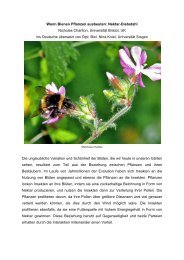PhDâ€theses - Ethologische Gesellschaft
PhDâ€theses - Ethologische Gesellschaft
PhDâ€theses - Ethologische Gesellschaft
Create successful ePaper yourself
Turn your PDF publications into a flip-book with our unique Google optimized e-Paper software.
Masters and Diplom theses<br />
THE ACOUSTIC RECOGNITION SYSTEM OF WILD BOARS (SUS SCROFA)<br />
lka Bürgener<br />
smanti@gmx.net<br />
Research Update<br />
Diploma thesis, supervised by Dr. R. Wanker and Prof. Dr. J. Schneider, Department of Biology,<br />
Zoological Institute & Museum, University of Hamburg<br />
Species, which live in complex social systems, evolve a broad vocal repertoire. Wild boars<br />
(Sus scrofa) live in matrilineal groups with a pattern of fission‐fusion and use a wide range of<br />
vocalizations. Several studies investigated the ability of individual recognition in both<br />
domestic pigs (Sus scrofa domestica) and wild boars but it is unknown to which extend<br />
acoustic cues are involved. Aim of this study was to examine the recognition ability by<br />
acoustic cues of wild boars, and more specifically to determine whether their vocalizations<br />
possess individual signatures and whether there are group‐specific calls. Furthermore I<br />
investigated whether infrasonic elements are present in long‐distance communication of the<br />
wild boars . I recorded the vocalizations of four wild boar groups in four different wildlife<br />
parks. The contact grunts were measured, analysed and classified by individuals. Playback<br />
experiments were carried out with one group to test the ability to discriminate familiar and<br />
unfamiliar conspecifics by their grunts. I found that contact grunts contain both individual<br />
and group‐specific signatures, but the playback experiment failed to verify that they can<br />
discriminate conspecifics by their contact grunts. Furthermore it turns out that wild boars do<br />
not use infrasonic calls for long‐distance communication, but their grunts contain very low<br />
frequencies, which may reach into the infrasonic range. These grunts were uttered in<br />
conflict situations, suggesting that the wild boars may intensify their aggressive message<br />
with these low frequencies.<br />
10



